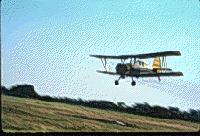
Kentucky Pest News mailings would normally switch to First Class mail at this time of the year. In compliance with a recent administrative decision prompted by postage costs, all departmental mailings with numbers of 200 or greater must be sent using Bulk Rate postage. With 1,300 subscribers, this will affect the KPN. Much of the information in this free newsletter is perishable and delays in bulk mail delivery may make recommendations or information in the articles obsolete by the time they are received.
There are two options to continue to get the
information in a timely manner. 1) Electronic
subscription The KPN is automatically sent by
email on the day it is written. If you have an
email account and would like to get the
newsletter in a timely manner, follow these
steps:
Send a message exactly as follows:
subscribe pestnews
end
Key Enter to create at least one blank line and
send
to: majordomo194@ca.uky.edu
You will be placed on the mailing list and will receive the issues by email immediately as they are posted, usually on Monday afternoons.
The Internet version usually is posted by noon on Tuesdays.
MAILING LIST UPDATE
Look for a form in the hard copy issue that must be
filled out and returned so that you will
continue to receive the KPN by mail.
Most readers who work with perennial ryegrass are aware of the emergence of gray leaf spot in the past decade as one of the most destructive turfgrass diseases known. Those of you with experience against gray leaf spot know how rapid and destructive the disease can be.
Fungicides remain our first line of defense against gray leaf spot, because all commercial varieties are susceptible and cultural practices can provide only limited control under high disease pressure. Because of the high cost of fungicides, many turf managers are interested in ways to use these important products more wisely and economically. My opinion is that at this time, there is no better way to optimize the use of fungicides than to scout your own swards for the disease and to microscopically verify the presence of the causal fungus in diseased tissues. Experienced turfgrass pathologists agree that microscopic verification is important because it is often not possible to positively identify this disease based on symptoms alone.
Proper scouting can help you decide:
The University of Kentucky Cooperative Extension Service will hold a workshop for turf managers and other interested professionals on microscopic identification of gray leaf spot of perennial ryegrass. Details are as follows:
Date & Time: June 20, 2001, from 1:00-5:00
Location: The University of Kentucky campus in Lexington
Cost: $900, Registration must be received by
Monday, May 7
While the cost may seem high at first glance, registrants
will actually be getting a lot for their money. Each
registrant will receive a high-quality compound binocular
light microscope (40-1000X magnifications, with halogen
illumination and high contrast lenses), which you will
learn to use during the workshop. In addition, each
registrant will receive dissecting kits, lense cleaning
supplies and other laboratory materials, a notebook
including color images, a 2X desk magnifier with built-in
illumination, and a field magnifying glass.
Learning Objective: As a result of this workshop, you will be able to detect Pyricularia grisea (the causal fungus of gray leaf spot) in diseased turfgrass tissue. This skill will provide the foundation for a scouting and monitoring program for gray leaf spot.
If interested in attending, please contact Pat Yancey
at
pyancey@pop.uky.edu
pyancey@pop.uky.edu for a registration form.
Registration is limited in order to provide a high-
quality learning experience for those who attend.
Interested Kentuckians should act soon, since out-
of-state registrants will be accepted on April 20.
Registration and payment must be received by
Monday, May 7.
Frankfort, KY If it sounds too good to be true, chances are, it is. That's according to officials in the Kentucky Department of Agriculture who say several vendors usually appear across the Bluegrass State about this time every year, selling ineffective chemicals at cut-rate prices.
"Each spring, we in the Department receive many complaints from home gardeners, farmers, and others who purchase cheap but ineffective chemicals over the telephone or on the Internet," said Billy Ray Smith, Commissioner of Agriculture. "The sellers of these products usually claim they're comparable to well- known national brands, and for some folks, the cheaper prices are hard to resist."
Pressure tactics are frequently used by sellers of such chemicals. "If the seller tells you to buy his product now or the deal will be gone forever, that's a strong indication that his product is no good," said John McCauley, Director of the Division of Pesticide Regulation.
The KDA's Ken Franks works with licensed pesticide retailers throughout Kentucky and says if you are considering buying a chemical product over the phone or on the Internet, you should ask the seller several questions.
--Ask for the products' EPA registration number.
--Call the KDA to ensure the product is registered for
use in Kentucky.
--Ask for the product's active ingredients and record
the percentages of each.
--Ask how many square feet or acres the product will
cover.
--Request complete directions for use of the product.
--Ask for the company's name, address, and
telephone number.
--Compare the product to a similar one offered by
your local retailer.
--Ask if the seller has a license to sell in Kentucky and
ask for his name and license number.
--Keep a record of all of this information.
"You should never buy a product that requires cash upon delivery," Franks said. "Sometimes these vendors will send you the product whether you ordered it or not, so be careful about who you talk with."
For additional information contact Ken Franks at (502) 564-7274 or
ken.franks@kyagr.com.

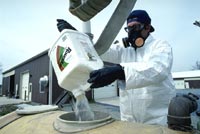 Most herbicide labels discuss mixing instructions
largely because this process can impact the
effectiveness of the spray mixture. It was
recognized several years ago that the sequence of
mixing herbicides together as tank mix
combinations can be important, particularly when
different formulations are included in the mixture.
The general rule for adding materials to the spray
tank is to start with wettable powders first, followed
by flowables, emulsifiable concentrates, and water
soluble liquids. Surfactants or oil concentrates are
usually added last. The specific sequence may vary
depending on products used.
Most herbicide labels discuss mixing instructions
largely because this process can impact the
effectiveness of the spray mixture. It was
recognized several years ago that the sequence of
mixing herbicides together as tank mix
combinations can be important, particularly when
different formulations are included in the mixture.
The general rule for adding materials to the spray
tank is to start with wettable powders first, followed
by flowables, emulsifiable concentrates, and water
soluble liquids. Surfactants or oil concentrates are
usually added last. The specific sequence may vary
depending on products used.
The 'jar test' method that is described on may product labels may help determine physical signs of compatibility of products but will not indicate the potential for antagonism as it relates to crop injury or weed control.
The use of nitrogen fertilizers such as 28% nitrogen, 10-34-0, or ammonium sulfate as additives can sometimes impact effectiveness of spray mixtures. Ammonium sulfate as well as 28% liquid nitrogen may reduce activity of Accent Gold, whereas, 10-34- 0 is the preferred source of nitrogen as an additive with this herbicide. The sequence in which nitrogen fertilizers are added in the spray mixtures may also impact the activity of certain herbicides. For example, ammonium sulfate should be included first when it is used with Roundup Ultra.
Some products are not very stable in water over time and should be sprayed soon after they are mixed. This is especially true of many of the sulfonylurea herbicides. In order to avoid product degradation, Accent Gold should be applied within 4 hours after mixing compared with 24 hours for Accent.
Consulting the labels of all materials involved in a spray mixture may help avoid problems with mixing, crop injury, or weed control.

 One method of applying some tobacco herbicides is
by use of impregnation onto dry fertilizer blends.
Impregnation of herbicides allow applicators to
make one trip across the field. However, adequate
weed control and crop safety from over application
is dependent on 1) uniform spraying of the
herbicide onto the fertilizer blend and 2) an even
application of the dry fertilizer blend to the field.
Prowl has been the most frequently applied tobacco
herbicide using impregnation on fertilizers.
Recently, Spartan 4F received an EPA label
amendment that also allows field applications by
impregnation on bulk fertilizers.
One method of applying some tobacco herbicides is
by use of impregnation onto dry fertilizer blends.
Impregnation of herbicides allow applicators to
make one trip across the field. However, adequate
weed control and crop safety from over application
is dependent on 1) uniform spraying of the
herbicide onto the fertilizer blend and 2) an even
application of the dry fertilizer blend to the field.
Prowl has been the most frequently applied tobacco
herbicide using impregnation on fertilizers.
Recently, Spartan 4F received an EPA label
amendment that also allows field applications by
impregnation on bulk fertilizers.
Previous field studies have shown that spreading of dry fertilizers often result in rate variations both across and along the spreader swath of the fertilizer material. This variation can obviously alter the herbicide distribution. Reduced weed control may occur in some areas of the field due to under application; whereas, the potential for crop injury increases due to over application in other areas.
Based on the distribution of fertilizer blends that could vary from 90 to 115% of the desired fertilizer application rate, uniformly impregnated Prowl 3.3EC (pendimethalin) herbicide applied at a target rate of 3.6 pt/A (1.5 lb ai/A) would vary between 3.25 pt (1.3 lb ai/A) to 4 pt/A (1.7 lb ai/A). This application variation of Prowl may not be enough to significantly alter the level of weed control observed in the field. On the other hand, impregnated Spartan 4F (sulfentrazone) applied at a target rate of 12 fl.oz/A (0.375 lb ai/A) would vary between 10 fl.oz/A (0.34 lb ai/A) to 14 fl oz/A (0.43 lb ai/A). Slight variation in Spartan rates could be enough to result in variable weed control and/or the increase potential for crop injury due to over application in some areas of the field. Therefore, extreme care should be followed in the fertilizer blending, mixing, and application when using dry bulk fertilizers to apply low rate dependent herbicides.
Always consult the herbicide label for proper application with dry bulk fertilizers. Additional information on applying dry bulk fertilizers can be found in a UK newsletter article titled "Using Solid, Bulk Blended Mixed-Grade Fertilizers" in Agronomy Notes Vol 12, No. 4 (1991).
For the latest blue mold status, check the KY Blue Mold Warning System.
![]() http://www.uky.edu/Agriculture/kpn/kyblue/kyblue.htm
http://www.uky.edu/Agriculture/kpn/kyblue/kyblue.htm
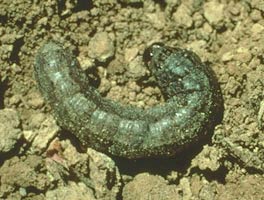 Small (3/4" long) variegated cutworms were found
feeding on tobacco seedlings in float trays in a
Rockcastle county greenhouse late last week. The
damage was confined to trays along the outside
walls and resulted from eggs laid by moths that had
been able to enter the house. This insect is a
potential problem in all float systems and can be
very damaging.
Small (3/4" long) variegated cutworms were found
feeding on tobacco seedlings in float trays in a
Rockcastle county greenhouse late last week. The
damage was confined to trays along the outside
walls and resulted from eggs laid by moths that had
been able to enter the house. This insect is a
potential problem in all float systems and can be
very damaging.
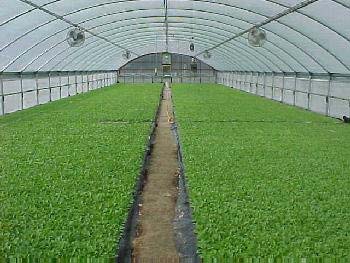 Orthene is the insecticide to use in the float system.
There can be both 75SP and 97 S available so check
the label for mixing instructions.
Orthene is the insecticide to use in the float system.
There can be both 75SP and 97 S available so check
the label for mixing instructions.
Female variegated cutworm moths lay over 2000
eggs during their short life span, usually in clusters
of 60 or more on stems or leaves of low-growing
plants. The larvae feed for 3 to 4 weeks before
wandering away to pupate. Often the large (abotu
2" long) caterpillars are found floating in the water
under trays.
For more information about tobacco pests, visit "Insect Management Recommendations".

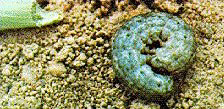 Last week, we received more reports of cutworms,
this time from no-till corn in western Tennessee.
Here's the quote from Dr. Russ Patrick, UT
Extension Entomologist, "Cutworms are ravaging our
corn in no till plantings. We have had at least several
thousand acres infested with them this April. Levels of
over 50% in some fields have been reported. I have seen
myself most of the damage in those fields. This is the
worst season I have seen with these little pests. " I have
also heard of similar reports from Alabama. So the
message for Kentucky corn producers is - watch
your corn very carefully over the next few weeks.
Last week, we received more reports of cutworms,
this time from no-till corn in western Tennessee.
Here's the quote from Dr. Russ Patrick, UT
Extension Entomologist, "Cutworms are ravaging our
corn in no till plantings. We have had at least several
thousand acres infested with them this April. Levels of
over 50% in some fields have been reported. I have seen
myself most of the damage in those fields. This is the
worst season I have seen with these little pests. " I have
also heard of similar reports from Alabama. So the
message for Kentucky corn producers is - watch
your corn very carefully over the next few weeks.
Considerable damage can be done over a short period of time, particularly during the cool weather as corn is growing more slowly and cutworms continue to feed on small seedlings. Preventive controls may be all the control that is needed in some situations, but with excessive cutworm infestations, preventive controls may not be sufficient. Significant damage can still occur in treated fields if cutworm populations are excessive. Fields should be scouted, even if they have had a preventive treatment.
The best strategy, will be to scout fields and use
rescue treatments as necessary. This has always
been the most cost effective when scouting is done
regularly (2 to 3 times per week). The worst strategy
will be to do nothing and leave cutworm losses to
chance. Judging by what has been observed to our
south, this is the year that it may pay to monitor
carefully for this corn pest.
For more information about corn pests, visit "Insect Management Recommendations".
 Broadleaf signalgrass is a warm-season annual grass
that can reduce corn yield by at least 25%. Growers
appear to have more difficulty in managing this
weed in corn compared with other row crops. The
problems are associated with a number of issues
including: 1) inconsistent control from soil-residual
herbicides, especially in no-tillage, 2) timeliness of
postemergence applications, and 3) antagonism of
postemergence herbicide tank-mixes.
Mistakes in identification are often a problem,
particularly for producers who have not had any
previous experience with broadleaf signalgrass.
Broadleaf signalgrass looks similar to crabgrass;
however, a close look at the collar region (where the
leaf blade attaches to the stem) can help differentiate
these two species from one another. The ligule (a
tongue-like structure on the inside of the collar) of
broadleaf signalgrass is a small ring of hairs
compared to a large membrane-like ligule for
crabgrass plants. Broadleaf signalgrass has hairs
along the leaf margins near the collar, yet there are
no hairs on the leaf blade surfaces. Also, the leaf
sheath (the portion of the leaf surrounding the stem)
of broadleaf signalgrass may have hairs, especially
on the lower leaves.
The seedhead of broadleaf signalgrass is made up of
2 to 6 finger-like branches scattered along the upper
portion of the stem and develop throughout the
summer. Mature plants grow 2 to 3 feet tall and
can develop roots along the lower nodes.
Some of the key identifying characteristics of
broadleaf signalgrass are illustrated in the below
figure.
Broadleaf signalgrass is a warm-season annual grass
that can reduce corn yield by at least 25%. Growers
appear to have more difficulty in managing this
weed in corn compared with other row crops. The
problems are associated with a number of issues
including: 1) inconsistent control from soil-residual
herbicides, especially in no-tillage, 2) timeliness of
postemergence applications, and 3) antagonism of
postemergence herbicide tank-mixes.
Mistakes in identification are often a problem,
particularly for producers who have not had any
previous experience with broadleaf signalgrass.
Broadleaf signalgrass looks similar to crabgrass;
however, a close look at the collar region (where the
leaf blade attaches to the stem) can help differentiate
these two species from one another. The ligule (a
tongue-like structure on the inside of the collar) of
broadleaf signalgrass is a small ring of hairs
compared to a large membrane-like ligule for
crabgrass plants. Broadleaf signalgrass has hairs
along the leaf margins near the collar, yet there are
no hairs on the leaf blade surfaces. Also, the leaf
sheath (the portion of the leaf surrounding the stem)
of broadleaf signalgrass may have hairs, especially
on the lower leaves.
The seedhead of broadleaf signalgrass is made up of
2 to 6 finger-like branches scattered along the upper
portion of the stem and develop throughout the
summer. Mature plants grow 2 to 3 feet tall and
can develop roots along the lower nodes.
Some of the key identifying characteristics of
broadleaf signalgrass are illustrated in the below
figure.

Postemergence Control: Research has shown that postemergence applications of Accent at 0.67 oz/A can provide approximately 90% control of broadleaf signalgrass. Basis Gold, Celebrity, and Celebrity Plus should provide control similar that achieved with Accent. However, early detection of broadleaf signalgrass and timely application of these products are necessary to obtain best results. Ideally they should be applied before broadleaf signalgrass plants exceed one to two inches in height (about 2- to 4- leaf stage of growth). Also, to achieve maximum control of emerged plants, treatments should be made before broadleaf signalgrass plants have tillered.
Antagonism can occur when these herbicides are tank mixed with other products. Reduced control of broadleaf signalgrass has been reported when Accent is combined with Marksman, Buctril, or 2,4- D. Although the antagonism has not been consistent in all studies, it may be wise to consult product labels before using tank mix combinations for broadleaf signal grass control.
The use of herbicide-resistant corn hybrids also allows several opportunities for managing broadleaf signalgrass. Lightning is registered to control up to 8-inch tall broadleaf signalgrass in Clearfield corn hybrids. Glyphosate products (e.g. Roundup UltraMAX, Touchdown, or ReadyMaster ATZ) should control 2- to 7- inch tall broadleaf signal grass in Roundup Ready corn.
Post-directed applications of Gramoxone MAX can be an effective and economical method for controlling broadleaf signalgrass in corn. However, very few corn farmers are equipped to do this method of application.
![]() As a result of serious SDS problems in many
soybean fields last season, I spent a considerable
amount of time during the 2000/2001 winter
meetings discussing SDS and risk avoidance for
future crops. One of the main points made during
each presentation was that many farmers who had
fields with serious SDS in 2000, generally set
themselves up for the problem by planting too early.
Many problem fields, especially those in the Green
River counties of Daviess, Henderson, and Union,
were planted in late April of last year.
Unfortunately, due to the soil and weather
conditions this spring, many fields were again
planted early. It is my understanding that many
soybean fields were, in fact, planted as early as mid-
April! The upshot of this is that SDS could be a
serious problem during 2001 if weather favors
disease development.
As a result of serious SDS problems in many
soybean fields last season, I spent a considerable
amount of time during the 2000/2001 winter
meetings discussing SDS and risk avoidance for
future crops. One of the main points made during
each presentation was that many farmers who had
fields with serious SDS in 2000, generally set
themselves up for the problem by planting too early.
Many problem fields, especially those in the Green
River counties of Daviess, Henderson, and Union,
were planted in late April of last year.
Unfortunately, due to the soil and weather
conditions this spring, many fields were again
planted early. It is my understanding that many
soybean fields were, in fact, planted as early as mid-
April! The upshot of this is that SDS could be a
serious problem during 2001 if weather favors
disease development.
To understand why SDS is favored by early planting, you must first be familiar with certain details regarding SDS epidemiology. The organism that causes SDS, Fusarium solani f.sp. glycines, is a root rot pathogen with great survival capabilities. The disease is initiated when F. solani infects soybean roots during the seedling and early vegetative stages. Later, one or more toxins are produced by the fungus which leads to above ground symptoms characteristic of SDS. Root infection by the SDS pathogen, thus, is a requirement for SDS to occur. This is a key point as this now relates back to planting date. Specifically, we need to focus on what soil conditions tend to be when soybean are planted in April. Generally speaking, soils are cool and wet. It just so happens that these same conditions favor infection by the SDS pathogen. As planting is delayed, soils warm and later planting dates, in particular, are not conducive to infection by F. solani. This is why we rarely see SDS in doublecrop soybean.
There are a great many observations and several research projects which support the above link between early planting and SDS. However, there has not been a great deal of work on the specific soil requirements for infection of soybean roots by F.solani. One study from Iowa associated great risk of SDS when soybean are planted at soil temperatures of 59F or less. Once soil temperatures reached 68F, the risk of SDS dropped off considerably. Finally, above 77F (i.e., typical soil temperature when doublecrop soybean are planted), the risk of SDS occurring is very low. These temperature/SDS categories generally fall in line with what we experience in Kentucky soybean crops. Of course, root infection by F. solani is also moderated and affected by soil moisture levels. Generally, adequate to excess soil moisture favors root infection.
Hopefully farmers will not experience serious SDS problems this summer. Nonetheless, extremely early soybean planting is a very risky venture in Kentucky.
Cedar rusts. Although moist weather has been rare during recent weeks, when there is moisture, cedar- apple rust galls and cedar-quince rust cankers on twigs and branches have been producing spores to infect apples. Unless more leaf wetness periods develop in the coming weeks, rust levels on apple and related hosts such as hawthorn may be low this year.
Apple scab. A few lesions on leaves of susceptible apples were observed recently in western areas of the state. These infections were initiated during the first week in April when the apple foliage was just beginning to emerge (green tip). Apples in the western and southern parts of Kentucky may be showing more symptoms than apples grown elsewhere because the emerging foliage would have been farther along at that time, thus posing a greater risk of apple scab infections. If the weather turns wet, these few primary infections can quickly develop into many secondary infections.
Fire blight. Fire blight symptoms are just beginning to appear statewide. In many trees, the "burned" shoots are not yet visible, but initial wilting of shoots associated with infected clusters is now visible. These shoots will soon die. Infected flower (fruitlet) clusters may show only one fruitlet with a blackened pedicel while the others are still green. Peeling the bark from the woody twig subtending an infected flower/fruit cluster will reveal internal browning and streaking indicating that the bacteria have already moved into the twig. Such twigs will show wilting shoot tips, early symptoms of fire blight.
Blackberry orange rust. Orange rust is appearing on shoots of blackberries statewide. Infected shoots may be stretched and deformed. Bright orange signs of the rust fungus are visible on leaf edges and on leaf undersides. Blackberries in commercial and backyard plantings which show rust symptoms should be removed and destroyed; infected blackberries growing in fencerows and weedy areas nearby should also be removed and destroyed.
Strawberry gray mold fruit rot. If growers intend to manage gray mold fruit rot with fungicides, the best time to make fungicide applications is now, when the strawberries are in bloom. Sprays made nearer to harvest after the fruits have formed or when they begin to ripen are not as effective.
For fruit disease management suggestions, the
following publications are available from your
County Extension Office:
Kentucky Commercial Tree Fruit Spray Guide 2001 (ID-92)
Kentucky Commercial Small Fruit and Grape Spray Guide 2001 (ID-94)
Disease and Insect Control Programs for Homegrown Fruit in Kentucky Including
Organic Alternatives (ID21)
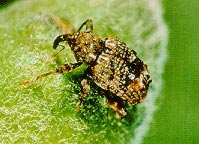 Petal fall has arrived and growers are assessing
what type of crop they will have in 2001. A late
freeze may have reduced crop loads on some
varieties in some areas. Now that we have reached
petal fall, its time to control for plum curculio. This
insect will become active over the next one to three
weeks. I have received a report of some plum
curculio damage in Casey county last week.
Petal fall has arrived and growers are assessing
what type of crop they will have in 2001. A late
freeze may have reduced crop loads on some
varieties in some areas. Now that we have reached
petal fall, its time to control for plum curculio. This
insect will become active over the next one to three
weeks. I have received a report of some plum
curculio damage in Casey county last week.
Currently, we don't have a reliable methods to monitor for this insect. The pyramid-shaped Tedder trap does catch the weevils and a beat sheet will also knock them from limbs. But we still recommend that growers apply a spray for plum curculio at petal fall and 10 to 14 days later at first cover. Using Imidan, Guthion, Danitol, or Avaunt for curculio control will also control early codling moths.
Codling moths are becoming active and may have reached 'biofix' in some orchards. Now is the time that growers need to be trapping for codling moth and checking the traps daily. The day that the fifth moth captured in the trap in the spring is the biofix date.

The following are spray programs for putting greens that have performed well in University of Kentucky research trials. All of these programs have been tested at application rates of 2.5 gallons per 1000 sq ft, and without watering in.
Banner MAXX 1 fl oz + Daconil Ultrex 3.7 fl oz
(applied biweekly)
An excellent time to use this is in spring up through
Memorial Day weekend, and again from around
Labor Day and beyond. This treatment can be used
through the summer, as well, as the rate of Banner is
low enough to not cause undesirable growth
regulation under most conditions. However, even
this rate will cause excessive growth regulation and
algae buildup if the green should develop
substantial stress from some other cause. It
provides excellent control of dollar spot and
anthracnose on creeping bentgrass. It provides
moderate control of brown patch. This treatment
provides no control of Pythium. Other DMI's can
be substituted for Banner MAXX, and other
chlorothalonil products are also available.
Signature 80WG 4 oz + Chipco 26GT 4 fl oz (applied
biweekly)
This tank-mix provides excellent control of dollar
spot and anthracnose and moderately good control
of brown patch. Where pressure from brown patch
is high, substitute Daconil for Chipco 26GT. It also
provides a complete Pythium control program.
Studies confirm that such combinations help
maintain health through certain summertime
stresses.
Heritage 50WG 0.2 oz+ Daconil Ultrex 3.7 fl oz
(applied every four weeks)
Signature 80WG 4 oz + Chipco 26GT 4 fl oz (applied
every four wk beginning 2 wk after above)
This treatment can be used from spring through
autumn, though it is wise to reserve good
summertime treatments for June-August and switch
to other products during less stressful weather. In
studies in Kentucky, this treatment consistently has
been among the top in terms of turf quality, and it
provides very good to excellent control of dollar
spot, anthracnose, brown patch, and Pythium. It
attempts to introduce fungicide rotation into the
spray program, while minimizing the use of any
particular mode of action. Additional Pythium
control may be needed on occasion, since under
high disease pressure, Heritage often provides no
more than 10 days of Pythium control.
Signature 80WG 4 oz + Chipco 26GT 4 fl oz (applied
biweekly) + Heritage 50WG 0.4 oz (applied every
four weeks)
Although we have only tested this for one year, this
treatment, devised by Dr. Joe Vargas at Michigan
State University, can be expected to provide very
good to excellent control of dollar spot, anthracnose,
brown patch, and Pythium. The program also
provides control of take-all of creeping bentgrass
and summer patch on Poa annua, for greens where
those diseases are concerns. It also takes advantage
of the stress protection provided by the Signature
tank-mixes. Turf quality was excellent in our 2000
test. I expect this treatment to be acceptable from
spring through autumn, though it is wise to reserve
these treatments for June-August and switch to
other products during less stressful weather.
Continued research with this spray program will be
conducted this summer.
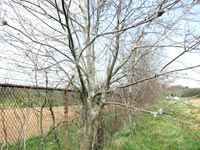 Many eastern tent caterpillars are finishing their
feeding and wandering off in search of pupation
sites. A check along a fence row set of heavily-
infested wild cherry trees turned up what appears
to be a virus disease that attacks these caterpillars.
Infected larvae tend to hang head down from twigs
and branches and have a flaccid appearance. A
reddish ooze can be seen on them. This is a good
sign in that virus diseases can cause population
crashes, especially at outbreak locations.
Many eastern tent caterpillars are finishing their
feeding and wandering off in search of pupation
sites. A check along a fence row set of heavily-
infested wild cherry trees turned up what appears
to be a virus disease that attacks these caterpillars.
Infected larvae tend to hang head down from twigs
and branches and have a flaccid appearance. A
reddish ooze can be seen on them. This is a good
sign in that virus diseases can cause population
crashes, especially at outbreak locations.
 Many caterpillars at the site were moving away
from trees and could be found at the tops of fence
posts 200' to 250' from the nearest host tree. It is no
surprise that they can be a nuisance far from the
trees on which they develop. We can expect them to
be on the move for about another 2 weeks.
Many caterpillars at the site were moving away
from trees and could be found at the tops of fence
posts 200' to 250' from the nearest host tree. It is no
surprise that they can be a nuisance far from the
trees on which they develop. We can expect them to
be on the move for about another 2 weeks.

Samples in the Diagnostic Laboratory last week included Rhizoctonia root and stem rot on canola; cold injury on wheat; Rhizoctonia damping-off, Pythium root rot, chemical injury, cold injury and freeze damage on tobacco; orange rust blackberry; blossom end rot on tomato; Pythium root rot on geranium; Rhizoctonia stem rot on vinca; dollar spot on bentgrass; black root rot on holly and inkberry; and tip blight on pine.

| UKREC-Princeton, KY, April 20 - 27, 2001 | |
| Black Cutworm | 0 |
| True Armyworm | 24 |
| Corn Earworm | 7 |
| European Corn Borer | 0 |
Lee Townsend
Extension Entomologist